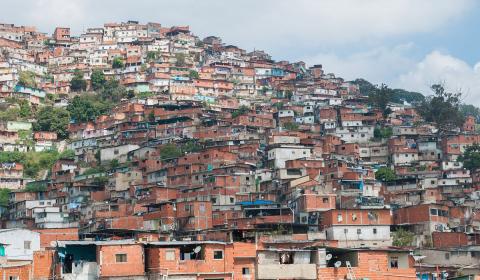
Gerry Lee, director of the Maryknoll Office for Global Concerns, wrote the following reflection for the Nonviolence and Justice Peace Conference in Rome in April. This article was published in the September-October 2016 issue of NewsNotes.
Serving as a Maryknoll Lay Missioner with my wife and three daughters in a slum on the edge of Caracas, Venezuela, I learned about the power of nonviolent action from the women leaders of the comunidades de base of the church of the poor. In our ten years in the barrios accompanying these liberation-theology-formed base communities, we witnessed the creativity, courage and resilience of women who are marginalized by the church as well as by society.
Building their tin-and-cardboard shacks as squatters on empty land on the edge of the city, these women laid down in front of the bulldozers and bayonets of the National Guard to defend their poor community when the government tried to dislocate them. They were catechists and spiritual leaders of the community who at the same time were denied the Eucharist by the official church because they were not married in the church, and often single moms abandoned by their husbands.
Our years in Venezuela witnessed the collapse of the ‘safety net’ for the poor and the doubling of extreme poverty in the urban slums as a consequence of neoliberal ‘structural adjustment’ policies. When people rose up in protests in 1989 at the imposition of the International Monetary Fund (IMF) austerity plan, the government sent the military to the slums to kill thousands of civilians who were ‘disappeared’ and buried in secret mass graves.
The base Christian communities then accompanied the families of the disappeared as they sought to find what had become of their husbands, sons and daughters. A conscience-stricken gravedigger led us to one mass grave site on the edge of a pauper’s cemetery called “La Peste” where centuries before victims of the Plague were buried. There the communities camped out for months with the families of the disappeared, guarding the site from the government, as we exhumed over 100 victims from the mass grave. While the government and some of the church even denied the existence of the mass grave, over those months we prayed together, laughed, and then cried together as the mothers among us failed to identify their loved one among the 108 bodies in black plastic bags that we pulled out of the earth.
Best estimates are that over 2,000 residents of the barrios of Caracas were ‘disappeared’ in March 1989. When the government repression worsened in an effort to stifle protest to the IMF’s austerity measures, the women leaders of our base Christian communities formed church human rights groups, organized cooperatives and “women’s circles” to counter the impact of “free trade” economics on the poor, and organized politically to eventually democratically elect one of their own, Hugo Chavez, to the presidency.
What did I learn about nonviolent action from these women church leaders of the slums?
First, even without training in nonviolence or an organized political movement, there was among these marginalized and oppressed communities a creativity, courage, and solidarity that became powerful tools for building a nonviolent response to systemic violence.
Second, the Catholic faith can be a powerful source of strength and solidarity even when it is largely unsupported by the institutional church. These women of the barrios grew as leaders in their small Christian communities with the accompaniment and support of foreign missioners such as Maryknoll and the Jesuits, but got almost no recognition or support from the hierarchy.
Third, the strength of the communities waned over time as spontaneous solidarity gave way to changing political currents and division; the lack of institutional support eventually discouraged long term growth.
Fourth, there are opportunities to build Gandhian ‘constructive’ nonviolence efforts taking advantage of the solidarity and strong relational traditions of marginalized communities. At the same time, these communities often make use of ‘obstructive’ nonviolent tactics.
We should invest our energy in building effective educational programs and solidarity efforts with lay leaders of the local church around the world. We also should encourage the Church to teach about just peace and the power of nonviolence.
While an encyclical on just peace would have tremendous teaching value to the faithful, I believe Pope Francis would also have us look away from Rome to many places where lay leaders of the local church, along with religious and clergy, are using effective nonviolence in the face of extreme violence.
Faith in action: Read and endorse the Nonviolence and Just Peace conference’s final statement, “An appeal to the Catholic church to re-commit to the centrality of nonviolence.” http://bit.ly/NVJustPeace2016.
Join the Catholic Nonviolence Initiative webinars starting September 13:http://bit.ly/CNIwebinar1.
